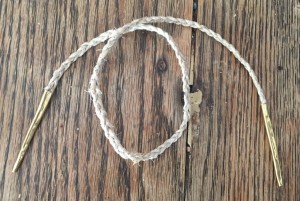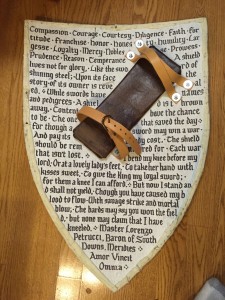Recently Her Highness Emelyne, Crown Princess of Meridies, asked me to suggest a dance to open her White Rose Ball, and I was happy to offer Lorayne Alman as an option that was simple, pretty, and (with the aid of musicians) able to go for as short or long a time as desired. As I suggested the dance, it behooves me to provide some instruction for those unfamiliar with the steps.
Lorayne Alman appears in one of the Inns of Court manuscripts from 1570, and matching music can be found in contemporary sources. Discussion of these sources can be found in Practise for Dauncinge. The steps are as follows:
Part A:
- 4 alman doubles forward, hopping
Part B:
- 1 alman double forward
- 1 alman double backward
- 1 alman double forward
- turn to the outside
- repeat Part B
All of the steps in this dance are doubles, which are with three steps and a pause: left, right, left, pause. A left double is done first, followed by a right double: right, left, right, pause. Left and right alternate for the duration of the dance. That said, it is generally not important (and, for ladies, not visible) if one is on the wrong foot in this dance.
While the source for this dance refers to the step simply as a “duble”, we look to Arbeau’s Orchesography (1589) for a description of how the double is done in an Alman. Arbeau describes it as “three steps and one grève or pied en l’air“, which is to say to take three steps and then raise the foot in the air on the fourth beat during the pause. It is not necessary to raise the foot quite as high as the illustration shows, though you are welcome to do so if you desire. In part A of this dance, there is also a hop on the fourth beat of the double, making the entire sequence step, step, step, hop with foot in the air.
Aside from doubles forward and back, there is a turn, which is done to the left by the men (who are standing on the left) and to the right by the ladies, so that they are turning away from each other and end facing forward once more. As far as the feet are concerned, this is simply another double that happens to go in a circle instead of a straight line.
There are two ways to determine that you are in the second part of the dance where the backward double occurs. First, you can listen to the music, which has a different melody for the A and B sections. Second, you may recall that the A section of the dance has doubles with hops at the end, while the B section has no hops. This means that if the couple in front of you just did a double with no hop, then you are about to go backwards. In any case, the music is not so fast that it is very difficult to change directions should you begin going forward instead of backward.
Music:
There is a commonly used arrangement of the music available here for musicians, and also recordings freely available for dancers to practice to:


 A shield lives not for glory,
A shield lives not for glory,